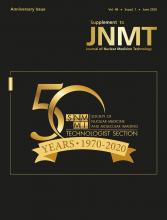In 1999, Martha Pickett, CNMT, FSNMTS, a past president of the SNMTS, gave a presentation at the Society of Nuclear Medicine (SNM) Southwest Chapter meeting to gather initial technologist feedback before exploring an advanced-practice pathway for NMTs in the United States. Because the response from the audience was so positive, a detailed SNMTS survey was created and mailed to technologist members. The results of this survey were published in the December 2000 issue of the Journal of Nuclear Medicine Technology (1). Conclusions indicated that the surveyed NMTs were routinely performing duties that exceeded the current scope of practice. Table 1 (1) lists the clinical tasks and levels of formal training identified as exceeding the scope of practice for current NMTs. Surprisingly, 63.8% were requested by a physician to provide an interpretation of a nuclear medicine procedure and 22.3% had administered morphine. In addition, 62% of the respondents indicated there was a need for the advanced-level NMT and 78% indicated the position would be helpful. The technologist survey was a clear indicator for the need for and interest in proceeding with the development of an NMT advanced-practice model in the United States. During these early discussions and surveys, the title of this profession was Nuclear Medicine Practitioner. After several iterations and discussions with the American College of Radiology, the Nuclear Medicine Practitioner title was changed to Nuclear Medicine Advanced Associate, thus the NMAA designation.
In 2005, a survey was sent to 1,500 physicians from the American Society of Nuclear Cardiology, American College of Nuclear Physicians, and American College of Radiology to assess physician support and intent (2). The results of this survey were as follows: 72.5% of the respondents thought that the NMAA would be helpful in performing exercise stress tests; 50.7%, in performing and interpreting electrocardiography; 83%, in being certified to provide advanced cardiac life support, 53%, in freeing up a radiologist, nuclear medicine physician, or cardiologist; 61.6%, in improving efficiency, especially in busy departments; and 64%, in being available when the direct presence of a physician is not possible.
On the basis of the results of the technologist and physician surveys, the SNMTS Advance Practice Task Force prepared a position paper that was published in the December 2006 issue of the Journal of Nuclear Medicine Technology (2). This paper addressed education and training issues. The next step was the development of a curriculum and competency standards. In 2008, the Nuclear Medicine Advanced Associate Curriculum Guide was developed by the SNMTS Advance Practice Task Force (3). Members of this task force included technologists, nurses, educators, pharmacists, and physicians. The 146-page curriculum reflects many of the guidelines of the Accreditation Council for Graduate Medical Education and outlines the learning objectives for the NMAA. Areas of focus include patient care, clinical nuclear medicine, interpersonal and communication skills, professionalism, practice improvement, and system-based practice. Also included are specific appendices from the American Society of Radiology Technologists on educational curricula for patient assessment, management and education, pathophysiology, pharmacology, and contrast media. In 2007, clinical competencies were established from the areas of education being created in the draft of the curriculum guide (4). In February 2010, with the adoption of the NMAA competencies and curriculum, the NMAA scope of practice was approved by the National Council of Representatives and the SNMTS Executive Board (5). This document outlines the guidelines or boundaries for what the NMAA should be able to perform with the additional education.
The vision and persistence of Martha Pickett and numerous members of the SNM and SNMTS created the foundation for the start of the NMAA profession in the United States.







